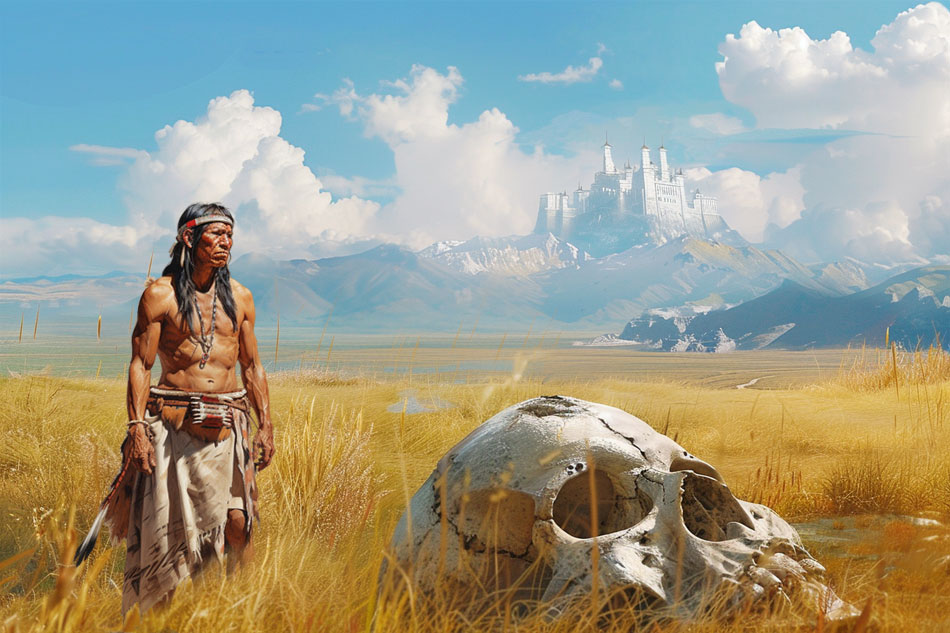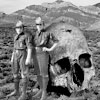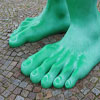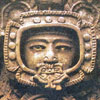Giants In Ancient America
 by Paul Schrag and Xaviant Haze
by Paul Schrag and Xaviant Haze
Despite being a prominent theme in all the world’s mythologies, the lore about giants generally remains in the realm of children’s tales. It seems odd then that ancient peoples from different parts of the globe would all write and speak of an age of giants.
Genesis 6:4 offers, “There were giants in the earth in those days; and also after that, when the sons of God came in unto the daughters of men, and they bare children to them, the same became mighty men which were of old, men of renown.”
In another famous biblical account we learn about the battle between David and Goliath. While digging at Tell es-Safi in 2005, archaeologists from Bar-Ilan University in Israel discovered pottery shards mentioning the name of Goliath. The writing on the shards represents the oldest Philistine inscriptions ever found. The area of Tell es-Safi was known in ancient times as the lands of Gath; it encompasses an area surrounding two large mounds located on the border between the Judean foothills and the coastal plain. Covering more than a hundred acres, it’s one of the most important archaeological sites in Israel. Professor Aren Maeir, director of the Tell es-Safi/Gath Archaeological Project, suggests that the discoveries being made there point to the legends being real.
He says in a press release issued by Bar-Ilan University, “This inscription appears to provide evidence that the biblical story of Goliath is, in fact, based on more or less, the time which is depicted in the biblical text, and recent attempts to claim that Goliath can only be understood in the context of later phases of the Iron Age are unwarranted.”
What’s more surprising than reified biblical accounts are stories of giants living in the West. Some of the American giants’ last days have been preserved in what remains of the writings of the conquistadors. The valuable information contained in the various writings from the Spanish invasion of the New World is so fantastic it’s hard to believe what they say.
Thanks to the tremendous amount of research done by Stephen Quayle, who brought to light the verified written accounts of giants from the early sixteenth century, there now appears to be bona fide written evidence that as little as five hundred years ago giants were living in the Americas.
In 1519, Alonzo Álvarez de Pineda mapped the lands along the Gulf Coast, strategically marking the various rivers and bays, noticeable landmarks, and porting areas, all of which belonged to the king of Spain. After covering the coastlines from Florida to as far as Tampico, Mexico, Pineda sailed back to the mouth of the Mississippi River. Pineda was the first Spanish explorer to venture up the mighty Mississippi, and he reports finding a large settlement of native villages inhabited by giants. After the giants proved to be friendly, Pineda and crew settled among them to rest and make repairs.
Pineda detailed the abundance of gold found in the river, and how the natives wore plenty of gold-engraved ornaments. It’s amazing how Pineda was more interested in the lands, good food, and the shock of discovering giants than he was in gold. As he sailed back to his home base in Jamaica, he made note of more giants encountered on the various islands of the Texas coast. When Pineda returned, he presented Francisco de Garay, the Spanish governor of Jamaica, with the maps and sketches of the entire Gulf Coast. The first known map of the gulf also included Pineda’s writings about the fantastic race of giants living there. These sketches and writings are known as Garay’s Cédula and were archived by the famous Spanish compiler Martín Fernández de Navarrete. They can be found today by visiting the Archivo General de Indias, in Seville, Spain.
Twenty years after Pineda mapped the Gulf, Francisco Coronado marched with a huge expedition across the American Southwest searching for the legendary Seven Cities of Cibola, or what we refer to today as El Dorado. While on their quest Coronado’s expedition crossed paths with several tribes of Indian giants. We have this information thanks to the writings of Pedro de Castaneda, who accompanied Coronado and wrote the complete and amazing history of the expedition. A fascinating tale concerning giants found in Castaneda’s book details the journey made by Hernando de Alarcón.
Low on provisions, a frantic Coronado sent Alarcón to find a river that could bring supplies more easily to the Spanish outposts along the California and Mexican coasts. After nearly destroying his ships and missing the waiting party at the rendezvous point, Alarcón haphazardly floated up the mouth of the murky Colorado River. Alarcón and his men became the first Europeans to fight the rough rapids as he brought his fleet into the heart of the Colorado River, reaching as far as the lower reaches of the Grand Canyon. While coasting up the river, Alarcón and his men came upon a settlement of an estimated two hundred giant warriors. These giants, amazed by foreign intruders on the riverbanks, were ready to attack.
But Alarcón defused the situation by making peace and offering gifts, which eventually won them over. These giants were later categorized with the prevailing tribes of the area as being the Cocopa Indians. A thousand more members of this giant tribe were discovered and reported farther upstream.
Discoveries of giants have also been reported in Mexico. The Dominican friar Diego Durán is responsible for writing some of the earliest Western books on the history and culture of the Aztecs. His family moved from Spain to Mexico City when he was very young, which allowed him to grow up around the remaining natives of Mexico. While attending school he was frequently exposed to Aztec culture, then under the colonial rule of Spain. He continued to study and travel within the remaining city-states of the Aztec empire. In Texcoco he learned to speak and read the native Nahuatl Aztec language. By winning the Aztecs’ trust, he was able to gain access to a vast amount of knowledge concerning the history of pre-Columbian Mexico.
His writings are some of the oldest known surviving texts that give us actual firsthand narratives from the ancient Aztecs. Because he spent thirty-two years among the Aztecs gathering information, learning how to read ancient native hieroglyphics, and interviewing old shamans, scholars regard Durán’s work as extremely important. In The History of the Indies of New Spain, he exhaustively describes the history of Mexico from its mysterious ancient origins up to conquest and occupation by the Spaniards. In these writings the Aztecs were not shy when it came to talking about giants.
But Durán didn’t need to hear or read about them. He could see them.
While living in Mexico he came in contact with giant Indians on several occasions. Writing about these encounters, he says emphatically, “It cannot be denied that there have been giants in this country. I can affirm this as an eyewitness, for I have met men of monstrous stature here. I believe that there are many in Mexico who will remember, as I do, a giant Indian who appeared in a procession of the feast of Corpus Christi. He appeared dressed in yellow silk and a halberd at his shoulder and a helmet on his head. And he was all of three feet taller than the others.”
Bernal Díaz del Castillo marched as a swordsman in the army under Hernán Cortés during the conquest of Mexico. After surviving these expeditions he lived to be an old man and wrote what is regarded as an exceptionally accurate narrative of the famous campaign. His book would come to be known as The True History of the Conquest of New Spain. Unfortunately Díaz died before seeing his book published.
Fifty years later the manuscript was found in a Madrid library. It was finally published in 1632. The book provides an eyewitness account of the conquest of Mexico, and it remains one of the most significant sources documenting the collapse of the Aztec Empire and the Spanish conquest of Mexico. Díaz recounts the history of the now-defeated Tlaxcatec Indians, mentioning a race of enormous giants that had once inhabited their land. During these encounters Díaz even had the chance to examine firsthand evidence of this long-forgotten race.
He writes:
They said their ancestors had told them that very tall men and women with huge bones had once dwelt among them. But because they were a very bad people with wicked customs they had fought against them and killed them, and those of them who remained had died off. And to show us how big these giants had been they brought us the leg-bone of one, which was very thick and the height of an ordinary-sized man, and that was a leg-bone from the hip to the knee. I measured myself against it, and it was as tall as I am, though I am of a reasonable height. They brought other pieces of bone of the same kind, but they were all rotten and eaten away by the soil. We were all astonished by the sight of these bones and felt certain there must have been giants in that land.
An Italian scholar from Venice, Antonio Pigafetta, traveled with famous Portuguese explorer Ferdinand Magellan and his crew on their voyage to the Indies. During the expedition Pigafetta became Magellan’s assistant and kept an accurate journal that detailed the various encounters with native giants. In Magellan’s Voyage: A Narrative of the First Circumnavigation, there are numerous references to giants. Pigafetta amusingly writes:
We had been two whole months in this harbor without sighting anyone when one day (without anyone expecting it) we saw on the shore a huge giant, who was naked, and who danced, leaped and sang, all the while throwing sand and dust on his head. Our Captain ordered one of the crew to walk towards him, telling this man also to dance, leap and sing as a sign of friendship. This he did, and led the giant to a place by the shore where the Captain was waiting. And when the giant saw us, he marveled and was afraid, and pointed to the sky, believing we came from heaven. He was so tall that even the largest of us came only to midway between his waist and his shoulder.
Pigafetta was among the surviving 18 men who returned to Spain in 1522. The other 240 men of the expedition all died, including Magellan.
Around the same time that Magellan was having his difficulties, the famed Italian explorer Amerigo Vespucci was charting the Caribbean islands off the coast of Venezuela. Amerigo, for whom one-third of the world would later be named, wrote about the giants he encountered on the modern-day island of Curaçao.
Recounting this experience, Vespucci writes, “We landed to see if we could find fresh water, and imagining that the island was not inhabited because we saw no people. Going along the shore we beheld very large footprints of men on the sand. And we judged if their other members were of corresponding size, that they must be very big men.”
As Vespucci and his men ventured into the island jungle he writes, “We discovered a trail and set ourselves to walk on it two leagues and a half inland; we met with a village of twelve houses in which we did not find anyone except five women, two old ones and three girls so lofty in stature that we gazed at them in astonishment.”
Vespucci and his men were invited to eat and drink. While doing so they formed a plan to kidnap the three exotic girls. But their plans dissolved quickly when the giant men of the village returned. In a state of anxiety, Vespucci recalls:
While we were thus plotting, thirty-six men arrived, who entered the house where we were drinking, and they were of such lofty stature that each of them was taller when upon his knees than I was when standing erect. Men that were so well built, it was a famous sight to see them. They were of the stature of giants in their great size and in the proportion of their bodies, which corresponded with their height. When the men entered, some of our fellows were so frightened that at the moment they thought they were done for. The warriors had bows and arrows and tremendous oar blades finished off like swords. When they saw our small stature, they began to converse with us to learn who we were and whence we came. We gave them soft words for the sake of amity and replied to them in sign language that we were men of peace and that we were out to see the world. In fact, we judged it wise to part from them without controversy, and so we went by the same trail by which we had come. They stuck with us all the way to the sea and until we embarked.
Vespucci and company made it safely back to their boats and fired off a few shots from their guns. The frightened giants scattered back into their villages, and Vespucci sailed away. He promptly named Curaçao the Isle of Giants.
One of the most famous and colorful figures of the American Old West was “Buffalo Bill” Cody, an American soldier, bison hunter, and early frontier showman. Buffalo Bill wrote in his autobiography about the strange beliefs of the Pawnee Indians. While camping with Cody and an Army surgeon, the Indians presented them with very large bones. One of them was supposedly a thighbone from a giant. Cody and the surgeon were amused as they listened to the Pawnee explain the origins of the bone.
Cody writes, “The Indians said the bones were of a race of people who long ago lived in that country. They said these people were three times the size of a man of present day, and were so swift they could run by the side of a buffalo, and taking the animal in one arm, could tear off a leg and eat it as they ran.”
He continues:
These giants denied the existence of a Great Spirit, when they heard the thunder or saw the lightning, they laughed and declared that they were greater than either. This so displeased the Great Spirit that he caused a deluge. The water rose higher and higher so that it drove these proud and conceited giants from the low ground to the hills, and thence to the mountains, but at last even the mountaintops were submerged and then those mammoth men were all drowned. After the flood had subsided, the Great Spirit came to the conclusion that he had made man too large and powerful, and that he would therefore, correct the mistake by creating a race of men of smaller size and less strength. This is the reason, say the Indians, that modern men are small and not like the giants of old. The story has been handed down among the Pawnee for generations, and they claim that this story is a matter of Indian history, but what is its origin no man can say.
The giant bones belonging to Buffalo Bill were eventually given to a museum, which promptly lost them.
According to an article published in the May 13, 1928, edition of the Humboldt Star, a nine-foot-tall red-haired mummy was discovered deep inside the Lovelock Cave, located twenty miles south of the town of Lovelock, Nevada. Isolated on top of a high hill, the cave is estimated to be 40 feet deep and 180 feet wide. The Piute Indians told the early Nevadan settlers fantastic stories about the origins of the cave, including tales about their fierce battles with red-haired white-skinned giants. In their oral history they claimed to have cornered the remaining giants in Lovelock Cave. Once the giants were trapped, the Piutes blocked the entrance with sagebrush and set it on fire. They reportedly stoked the fire until all the remaining giants had been smothered by smoke.
Further evidence supporting local legends about giants had emerged in 1911 when a mining company plowing for bat guano in Lovelock Cave began to find amazing artifacts. They discovered layers of burned materials and broken arrows that validated the Piutes’ claims. Further down they found the remains of giant red-haired mummies, along with strange stone artifacts and shells carved with mysterious symbols. As usual most of these artifacts were either lost or fell into the hands of private collectors who whisked them away. One museum did manage to preserve some of the items discovered at Lovelock Cave.
The Humbolt County Museum at Winnemucca, Nevada, has in its collection a skull from one of the giants. Stan Nielsen, the famed treasure hunter, pilot, and photojournalist, went to investigate this skull with some dental plaster and a camera. The museum curator graciously allowed Nielsen to compare the plaster model of a normal-size man’s jaw with a jaw of one of the giants found in the museum’s collection. The photographic evidence clearly shows the vast difference in size between the plaster model and the immense jaw from the giant skull. What’s more amazing is that anyone can see this skull for themselves by contacting the friendly staff at the Humbolt County Museum. Recent e-mail transactions have verified that some of the sensational Lovelock Cave artifacts, including a giant skull, are being kept in the back room of the museum.
But stories about similar sensational discoveries continue to this very day. An article published online June 29, 2010, by National Geographic titled “Diver ‘Vanishes’ in Portal to Maya Underworld” discusses the recent exploits by the Belize Institute of Archaeology, which was busy exploring the underwater cave system in Belize. Seemingly buried in the article is the important statement made by lead archaeologist Lisa Lucero concerning the discovery of several fossil beds 60 to 90 feet below the surface. While diving and digging through these deep fossil beds, Lucero discovered “femur bones the size of a bowling ball.” These giant bones were discovered near elephant tusks and pelvic bones. Lucero admits to leaving the giant bones behind, saying, “We left those in place. We only removed a few small fossils so we can determine, are they fossilized? Or bone? They are definitely fossilized, so we know they have to be of a certain age. But were they here, were these mega fauna present during occupation by humans 20,000, 15,000 years ago? Or are they much older?
The remains of ancient giants in America are scarce, but evidence, both empirical and anecdotal, does exist. By reading the various newspapers and town journals of the 1800s a serious investigator will find a surprising number of stories about discoveries concerning giants. Many tales emerge from mounds that were being excavated by hordes of new frontiersmen moving west along the trail blazed by the Corps of Discovery.
Excerpt from The Suppressed History of America
Ancient Giants of North America
Posted in Other Topics, True History of Manwith comments disabled.




